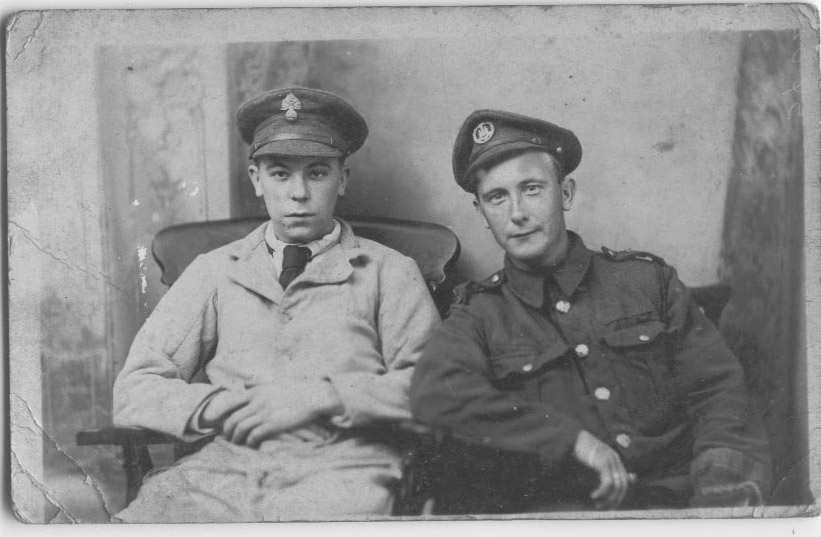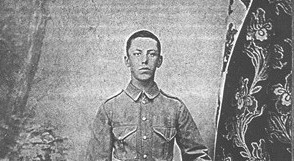S. F. WhitingService no. F/13871Aircraftman 1st Class, Royal Naval Air Service, H.M.S. President IIDied of illness on 27 January 1918, aged 20CWGC: “Son of Benjamin F. and Augusta Whiting, of 85 Lark Hall Lane, Clapham, London.”Remembered at Wandsworth (Streatham) Cemetery, Garratt Lane, London SW17 Information from the censuses In 1911 Clapham-born Stanley Franklin Whiting was […]
George Robert Henry Wedderburn
G. WedderburnPrivate, London Regiment, 19th Bn. Service no. 611750Died of illness in early 1919, after discharge, aged 26Buried in Southwark 6 March 1919 Chris Burge writes: George Wedderburn was born on 30 August 1892, the first child of George Wedderburn and Clara Wilmott of 5 Chapel Street (since renamed Mowll Street), Stockwell. George was baptised […]
Frederick James Edmund Spencer
F.J. SpencerSecond Lieutenant, Wiltshire Regiment Died of influenza as a prisoner of war on 9 November 1918, aged 23 Remembered at Niederzwehren Cemetery, Kassel, Germany Chris Burge writes: Frederick James Edmund Spencer was born on 25 September 1895 in the Manchester area (Date of birth as in CWGC records, alternatively 25 September 1896 as recorded […]
Thomas Albert Pilgrim
T. A. Pilgrim Service no. 8761 Company Quartermaster Serjeant, Cheshire Regiment, 86th Bty. Born in Battersea; enlisted in London Died of pneumonia on 19 May 1918, aged 35 CWGC: “Son of Mrs. S. Silk (formerly Pilgrim), of 3, Stockwell Grove, Stockwell, London, and the late H. Pilgrim. Served in the South African Campaign. Alternative Commemoration […]
Joseph Charles Murray
Died in London on 7 May 1920 from illness
Herbert Thomas Head
H.T. Head. Private, 3rd Reserve Cavalry RegimentService no. 7211Died on 26 December 1916, aged 37, after discharge Chris Burge writes: Herbert Thomas Head was born in 1879 to parents William and Sarah. He was baptised Herbert Thomas William Head, at St Stephen’s, Villa Street, Walworth Common, Southwark, on 21 August 1879. His father William was […]
Bernard Allen Miller Dunning
B. A. M. Dunning Service no. 558257 Driver, Royal Engineers, Army Signal Company Died of dystentery age 39 on 6 December 1918 Son of Mrs Julia Dunning; husband of Rosina Harriet Dunning, of 17, Somerleyton Road, Brixton, London. Born in Dorset. Remembered at Baghdad (North Gate) War Cemetery, Iraq British Army WWI Service Records 1914-1920 […]
Geoffrey William John Dee
G.W.J. DeePrivate, 24th (County of London) Bn (The Queen’s)Service no. Regiment 720356Died on 15 February 1920, aged 23, after discharge Chris Burge writes: Geoffrey Dee was born on 26 November 1896 in Woolwich, southeast London, the first child of John Edwin and Emma Churchill (née Loftin) Dee, who had married earlier in the year. Geoffrey […]
William Edward Crabb
W. Crabb Service no. M2/150639 Private, Army Service Corps, 618th M.T. Coy. Died of cerebral malaria (“due to field operations”) on 23 May 1917, aged 39 CWGC: “Son of Richard and Mary Ann Crabb; husband of Alice Beatrice Crabb, of 19 Thorne Rd., South Lambeth, London. Born in London. Served in the South African Campaign.” […]
Edward George Cox
Chris Burge writes: E.G. CoxRifleman, London Regiment (London Irish Rifles), ‘B’ Coy. Service no. 590198 Died in hospital in the UK on 18 February 1919, aged 22Remembered at West Norwood Cemetery and Crematorium Edward George Cox was born on 10 May 1896 and baptised at Holy Trinity (demolished in 1953), Vauxhall Bridge Road in Pimlico […]


